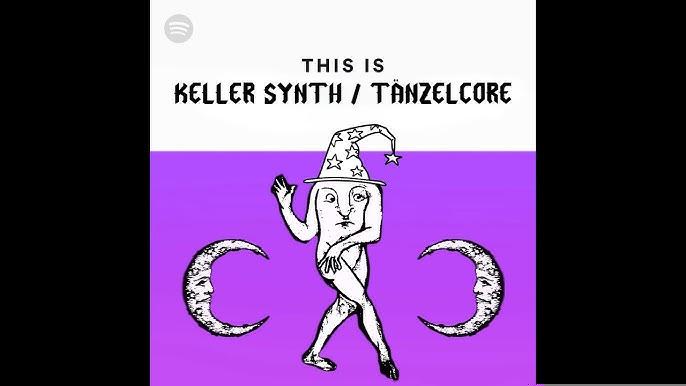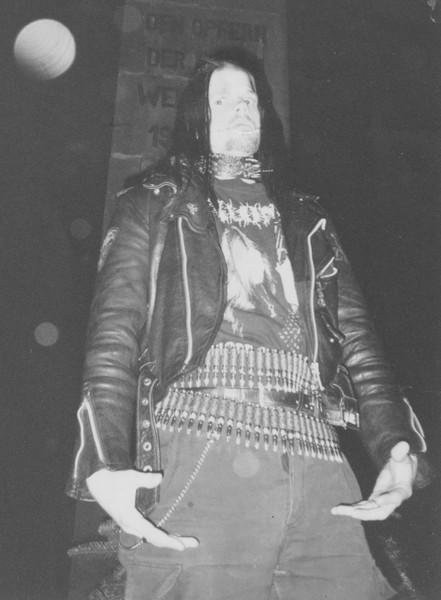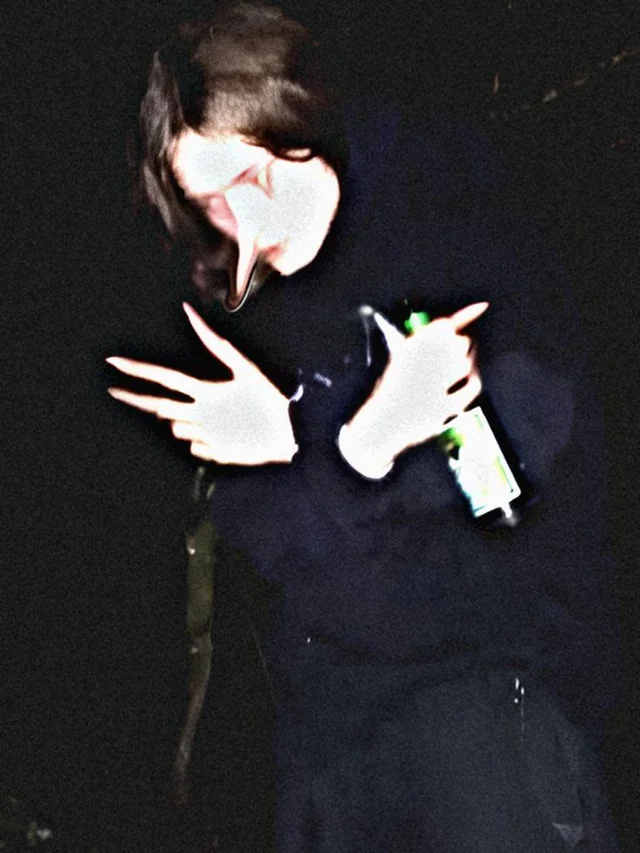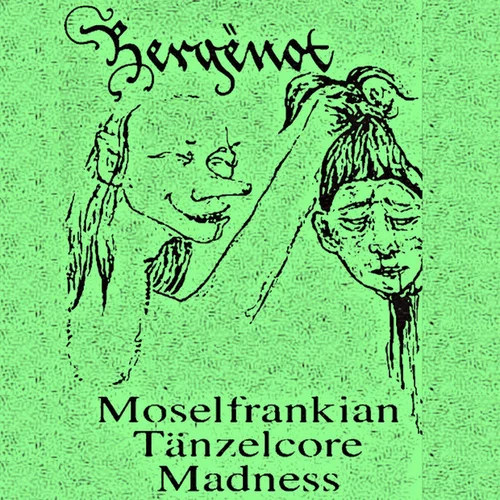
English version below
(IT) Black metal senza chitarre, rave senza techno, scantinati senza luce
Il Black Metal è morto. Poi è risorto. Poi è morto di nuovo. Alla fine è andato in putrefazione. Dai suoi resti sono nate due muffe: il Keller Synth, cioè il black metal senza chitarre, e il Tänzelcore, cioè la stessa muffa lanciata all’interno di un rave HardTekno.
L’inizio del Keller Synth si perde nella Germania appena unificata degli anni Novanta, quando BSOD, alias giovanile di Andreas Bettinger, percepì che una drum machine e un vecchio registratore a nastro erano sufficienti per evocare il male. Nessun gruppo, nessuna chitarra: solo riverbero, tastiere elettroniche estremamente economiche e registrazioni fatte in uno scantinato. Era l’opposto della perfezione distinta e ricercata norvegese, quasi una dichiarazione d’intenti. In un vecchio thread su Dungeon Synth Proboards qualcuno scriveva: “BSOD non aveva strumenti, non aveva soldi, non aveva speranza. E per questo ha creato il suono più vero di tutti: la cantina che parla da sola.”

Il parallelismo con Mortiis (bassista degli Emperor in prima ora e probabile padre putativo del Dungeon Synth in seconda ora) è naturale, ma non ci sono qui alcun goblin, nessun castello. BSOD era un tossicomane di eroina, un personaggio borderline che aveva reso decadimento linguaggio. Un utente di Reddit lo ha così descritto: “Il Mortiis degli sfigati, ma più vero perché non fingeva: lui era veramente distrutto.”
Intorno a questo nucleo, nei decenni, si è formata una piccola galassia. Sigfried, chiamato anche Friedhof o Grollfri, è il più fermentante dei nomi: pubblica cassette, remix e compilation, tenendo accesa la fiamma. Su un post su forum tedesco Schwarz Klang si legge: “Friedhof non prende sul serio nemmeno se stesso, ma continua a far uscire tape su tape come se fosse l’unico custode del Keller Synth.” E forse lo è davvero. Quindi ci sono figure come Corneus, più vicino al rumore puro, e Windgeist, evocato spesso nelle discussioni come scriba e testimone della scena.

In Italia il Keller Synth si è presentato con Hicken Sort, che ha trasfigurato la sua musica in dei meme più o meno seri. Nei forum stranieri il suo album viene spesso citato come esempio di “trash geniale”. Qualcuno ha scritto: “Non so se ridere o venerarlo, ma questo è il disco Keller più Keller di tutti.” E in effetti lo è proprio: ridicolo e spaventoso al tempo stesso, perfettamente aderente all’estetica del marcio.
L’estetica del Keller Synth è irripetibile: copertine bianche e nere, fotocopie sgranate, loghi illeggibili. Non è per orecchie fine: il difetto qui è la qualità. Sulla community ufficiale r/dungeonsynth del sito di Reddit qualcuno l’ha descritto come “il rumore che fa la muffa quando ti mangia il cervello”. Le produzioni non si orientano alla limpidezza ma al marcio, e come dice un altro user: “Se registri con un microfono decente, non è più Keller.”
Da questa “muffa” nasce il Tänzelcore, la degenerazione gabber. Il concetto è semplice e ridicolo: prendi il Keller Synth e spingilo ai limiti del umanamente possibile, con bpm tekno hardcore e kick implacabile. In un post su Proboards qualcuno l’ha descritto così : “La versione tecnica di un funerale in cantina. Balli, ma piangi.”
Il Tänzelcore esplode grazie a realtà come Crufty, che con lo pseudonimo di Toten Cruft pubblica gabber necro sulla label Eenfell, o DunkelRave, rave fatto in contesti urbani tipo vecchi capannoni industriali abbandonati. Negli Stati Uniti Fester Witch spinge la formula al noise, mentre sopracitato Friedhof rimane al centro anche di quest’evoluzione, pubblicando Tanzelcore Vol. 1, che nelle chat viene spesso richiamato come la Bibbia del circuito. Un esempio: “Se non hai sentito Tanzelcore Vol. 1, non puoi parlare. Punto.”

L’estetica silente: il nero e bianco si abbassa di fronte a flyer colorati di viola e rosso, con glitch computerizzati e simboli esoterici. Svastiche, rune, croci rovesciate: tutto viene reinterpretato in chiave ironica e kitsch. E qui ci sono le polemiche. Su Metal Archives uno degli utenti dice: “Il Keller Synth era stupido ma innocente. Il Tänzelcore, però, potrebbe sembrare nazi-gabber.” Altri rispondono: “Se ti offendi sei mainstream. Noi balliamo con i morti, non con le ideologie.”
Le geografie di questa tipologia sono disseminate: la Germania è il nucleo palpitante, gli Stati Uniti sono il laboratorio delle contaminazioni noise-rave, l’Italia con Hicken Sort è un culto ironico, e nell’est Europa il Tänzelcore si riunisce nei rave improvvisati dentro officine abbandonate. In un report semi-apocrifo su un blog tedesco si legge: “Una sera del 2022 a Berlino Est, un gruppo di venti persone danzava Tänzelcore in una cantina. La polizia lo ritenne una setta satanica. Non aveva tutti i torti.”
La discografia è sempre esigua ma sufficiente per tracciare la lingua musicale. Tanzelcore Vol. 1 del 2021 è la spina dorsale. DunkelRave’s Rave für die Dunkelheit del 2022 ha spalancato la porta più tecn-industrial. Toten Cruft’s Gabbergeist del 2023 ha spinto la sovraesposizione al limite. Friedhof ha completato la serie con Tanz der Toten. E in tutto il pasticcio rimane tuttora la leggenda dei demo di BSOD, introvabili e sacri come reliquie.
Il Keller Synth e il Tänzelcore non sono resurrezioni nostalgiche, delle semplici presse in derisione. Sono la prova che l’underground non cessa di generare deformità, ridendo della propria salma. In un post anonimo su un thread chiuso di Proboards si poteva leggere: “Il Keller Synth è il suono di un black metal che sorride mentre si autoannienta. Il Tänzelcore è quel cadavere che poi si mette a ballare.”
Ed è questo il punto. La cantina è viva. La muffa è attiva. E se puzza, tanto meglio.

(EN) Black Metal Without Guitars, Rave Without Techno, Basements Without Light
Black Metal is dead. Then it resurrected. Then it died again. In the end, it rotted. From its remains, two molds were born: Keller Synth, meaning black metal without guitars, and Tänzelcore, meaning the same mold thrown into a HardTekno rave.
The origins of Keller Synth are lost in the newly unified Germany of the 1990s, when BSOD, the teenage alias of Andreas Bettinger, realized that a drum machine and an old tape recorder were enough to evoke evil. No band, no guitars: just reverb, extremely cheap electronic keyboards, and recordings made in a basement. It was the opposite of the distinct and refined Norwegian perfection, almost a statement of intent. In an old thread on Dungeon Synth Proboards, someone wrote: “BSOD had no instruments, no money, no hope. And that’s why he created the truest sound of all: the basement speaking for itself.”
The parallel with Mortiis (the original bassist for Emperor and the probable godfather of Dungeon Synth) is natural, but there are no goblins or castles here. BSOD was a heroin addict, a borderline character who had made decay his language. A Reddit user described him like this: “The Mortiis for losers, but more real because he wasn’t pretending: he was truly destroyed.”

Around this nucleus, a small galaxy formed over the decades. Sigfried, also known as Friedhof or Grollfri, is the most fermenting of the names: he releases cassettes, remixes, and compilations, keeping the flame alive. A post on the German forum Schwarz Klang reads: “Friedhof doesn’t even take himself seriously, but he keeps releasing tape after tape as if he were the sole guardian of Keller Synth.” And maybe he really is. Then there are figures like Corneus, closer to pure noise, and Windgeist, often evoked in discussions as a scribe and witness of the scene.
In Italy, Keller Synth appeared with Hicken Sort, who transfigured his music into more or less serious memes. On foreign forums, his album is often cited as an example of “genius trash.” Someone wrote: “I don’t know whether to laugh or worship him, but this is the most Keller Keller album of all.” And indeed it is: ridiculous and scary at the same time, perfectly adhering to the aesthetic of rot.
The aesthetic of Keller Synth is unrepeatable: black and white covers, grainy photocopies, illegible logos. It’s not for fine ears: the flaw here is the quality. On the official r/dungeonsynth community on Reddit, someone described it as “the noise mold makes when it eats your brain.” The productions don’t aim for clarity but for rot, and as another user says: “If you record with a decent microphone, it’s not Keller anymore.”

From this “mold,” Tänzelcore, the gabber degeneration, is born. The concept is simple and ridiculous: take Keller Synth and push it to the limits of human possibility, with hardcore tekno BPM and a relentless kick. In a Proboards post, someone described it like this: “The techno version of a funeral in a basement. You dance, but you cry.”
Tänzelcore exploded thanks to entities like Crufty, who, under the pseudonym Toten Cruft, releases necro gabber on the Eenfell label, or DunkelRave, raves held in urban contexts like old abandoned industrial warehouses. In the United States, Fester Witch pushes the formula towards noise, while the aforementioned Friedhof remains at the center of this evolution too, releasing Tanzelcore Vol. 1, which in chats is often referenced as the Bible of the circuit. An example: “If you haven’t heard Tanzelcore Vol. 1, you can’t talk. Period.”

The silent aesthetic: the black and white gives way to flyers colored in purple and red, with computerized glitches and esoteric symbols. Swastikas, runes, inverted crosses: everything is reinterpreted in an ironic and kitschy key. And here come the controversies. On Metal Archives, one user says: “Keller Synth was stupid but innocent. Tänzelcore, however, might seem like Nazi-gabber.” Others retort: “If you get offended, you’re mainstream. We dance with the dead, not with ideologies.”
The geographies of this typology are scattered: Germany is the beating heart, the United States is the laboratory for noise-rave contaminations, Italy with Hicken Sort is an ironic cult, and in Eastern Europe, Tänzelcore gathers in impromptu raves inside abandoned workshops. A semi-apocryphal report on a German blog reads: “One evening in 2022 in East Berlin, a group of twenty people was dancing Tänzelcore in a basement. The police thought it was a satanic cult. They weren’t entirely wrong.”
The discography is always scant but sufficient to trace the musical language. Tanzelcore Vol. 1 from 2021 is the backbone. DunkelRave’s Rave für die Dunkelheit from 2022 blew the door wide open towards techno-industrial. Toten Cruft’s Gabbergeist from 2023 pushed overexposure to the limit. Friedhof completed the series with Tanz der Toten. And amidst the whole mess, the legend of the BSOD demos remains, untraceable and sacred like relics.
Keller Synth and Tänzelcore are not nostalgic resurrections, nor simple acts of mockery. They are proof that the underground never ceases to generate deformities, laughing at its own corpse. In an anonymous post on a closed Proboards thread, one could read: “Keller Synth is the sound of black metal smiling as it self-destructs. Tänzelcore is that corpse then starting to dance.”
And that’s the point. The basement is alive. The mold is active. And if it stinks, all the better.

